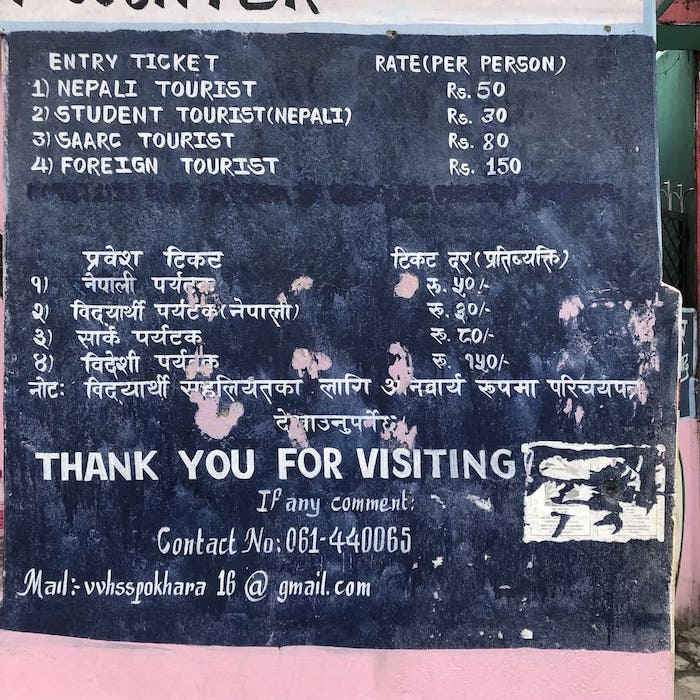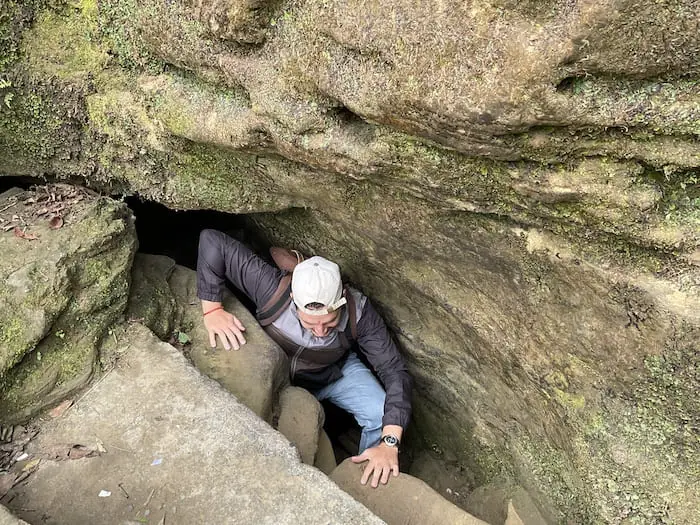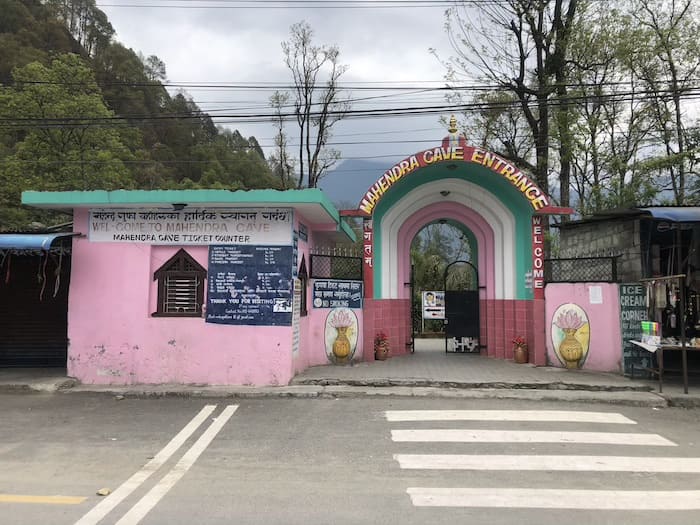The Mahendra Cave is a popular tourist destination in Pokhara. A sizable limestone cave in the western part of Pokhara, at about 1100 meters above sea level, gives the adventurous a chance to experience the city’s caverns and religious sites. As one of the most popular caves in Pokhara, the Mahendra Gufa allows visitors to go underground and see a statue of Lord Shiva, a Hindu deity.
The Mahendra Cave is rich with various rocks and stones that sparkle when a light source shines through them. The Gufa (Nepali for cave) also has large rock boulders and tunnels that lead to other locations, such as the Kali Khola (River), but many of the tunnels are currently blocked by enormous rock boulders. Wild bats also live in the cave; several may be observed in the pitch-black ceilings.
Mahendra cave is a must-see if you’re in Pokhara with some free time and are interested in caverns and antiquated objects. This blog discusses some of the most interesting aspects of the cavern and helps you decide if you are brave enough to venture into the dark, underground cave!
Mahendra Cave – A Historical and Religious Location

Thousands of people visit the cave each month to bask in its natural beauty. Mahendra cave has a length of about 200 meters (about 660 feet) and is one of the most popular caves in Pokhara. The other two caves that tourists frequent include the Gupteshwor Cave and the Bat Cave (Chameri Gufa).
Located in Batulechaur, Pokhara, the cave is about 20 minutes from Lakeside. The Mahendra Gufa is a great place to view the natural structure and ancient natural wonders since it is packed with limestone that keeps eroding with the aid of water.
In Mahendra cave, different types of rocks and stones sparkle when exposed to light. It also features gigantic granite rocks and tunnels leading to other places, such as the Kali Khola (River). However, many of the tunnels are hidden and blocked by enormous boulders. Additionally, the cave is home to a sizable population of bats, which can be seen on the dim ceilings of the cave (nothing compared to the number of bats in the Bat cave!).
Finally, a statue of the Hindu deity Lord Shiva is located inside the cave. Moreover, on the cave walls, some strange carvings resemble human figures of Hindu deities. The statue and carvings attract religious tourists and pilgrims, making the shrine an important component of religion in Nepal.
The cave is 275 meters long, 16 meters wide at the entrance, and approximately 3 1/2 meters wide in the center. The cave is easy enough to enter and navigate through. However, despite a row of light bulbs mounted to the cave’s walls, the electrical supply still needs to be more stable. Making the cave quite dark. Therefore, make sure you have a light source with you.
The History of the Mahendra Cave in Pokhara:

Shepherds in the Pokhara valley discovered the cave in the 1950s. When first found, the cave was known as “Adhero Bhawan.” In 1953 AD, senior culture expert Satya Mohan Joshi made a trip to the cave. He then published a story about the cave in a Newari newspaper which King Mahendra Bir Bikram Shah Dev, the nation’s reigning monarch, read. After he read the story, the King visited the Gufa in Pokhara and decided to protect the site by naming it after himself.
A small group of UK speleologists, including Jane Wilson-Howarth, conducted the cave’s first comprehensive survey in 1976, recording the creatures that resided there. The Royal Geographical Society and the UK copyright libraries both have copies of the expedition report on file.
What is the Entrance Fee for Mahendra Cave?

The entrance fee for the cave for Nepali nationals is NPR 50, NPR 80 for residents of SAARC nations, and NPR 150 for foreigners.
The Mahendra cave is accessible every day from 9 am to 6 pm. The cave may be closed on certain holidays and festivals. Finally, you will need about two hours to visit the entire cave and the surrounding area.
Other Activities to do while visiting the Mahendra Gufa:
The Gufa is located in the northwest portion of Pokhara, Kaski. Even though you have to travel a good distance to reach the Mahendra Gufa, there are other attractions around the area that you can visit. These include the Chamere Gufa (Bat Cave), Seti River Gorge, and the Gorkha Memorial Museum.
A few other things you can do while visiting the cavern in Pokhara include:
- Chamere Gufa (Bat Cave)
- Seti River Gorge
- Gorkha Memorial Museum
- Jangchub Choeling Monastery
- Vhalam Long Bridge
What are the operating hours of Mahendra Cave in Pokhara?

Mahendra Cave in Pokhara is open from 7:00 A.M to 6:00 P.M.
Some holidays and religous ceremonies will result in the opening hours being different, or the cave being closed all together. So make sure you are aware of the major festivals in Nepal!
When is the best time to visit the Mahendra Cave?
The best time to visit the Mahendra Gufa in Pokhara is from October to November and February to April. You will want to avoid visiting the cave during monsoon season.
You can, of course, visit the cave at any time, as it is open year-round. However, it can be full of water and extremely damp during the monsoon season.
Quick facts about the Mahendra Gufa in Pokhara:
Below are some quick and interesting facts about the famous cave in Pokhara.
- The cave was named after King Mahendra
- The cave is a habitat for bats. Visitors can see bats hanging from the dark, damp ceilings.
- Earlier, there were attempts to light the cave completely, but under demand from the locals and environmentalists, some lights had to be moved, and others had to be removed.
- The most abundant mineral in the cave is limestone.
- The cave can be extremely slippery at times – especially the entrance stairs.
- The cave is quite damp, and water drips from the ceiling. Therefore, it’s advised not to visit the cave during monsoon season.
- When you shine your light on the limestone, it sparkles. The glistening stones add a bit of appeal to the journey.
- Take a light with you – your phone’s flashlight will work!
- Visitors claim that the entrance resembles a tortoise shell.
- Many stalagmites and stalactites can be seen inside the cave.
- A large stalagmite at the far end of the cave represents Lord Ganesh.
Mahendra Cave in Pokhara

The famous Gufa in Pokhara is one of the most famous caves in the city. It attracts thousands of visitors and tourists every week. With its religious importance and natural beauty, it is no surprise that people love visiting the historic cave.
Mahendra Gufa is a great place to visit if you are a brave and adventurous traveler! It allows you to see the bats hanging from the ceiling while you travel further underground through the dark and damp cave.
If you have free time and are looking for something to do in Pokhara, make sure to visit the Mahendra Cave in Pokhara! If you need some other fun ideas, make sure to also check out my Pokhara travel guide!
FAQs: Mahendra Cave
After reading about the cave in a Newari language newspaper, Late King Mahendra Bir Bikram Shah Dev, visited the site and decided to name it after himself. Thus, when the cave was formally inaugurated by King Mahendra, it was given the name “Mahendra Cave” in honor of the monarch.
In addition to its stunning lakes and trekking spots, Pokhara boasts extraordinary caves that leave tourists in awe. Mahendra Cave, Gupteshwor Cave, and Bats’ Cave are among the famous caves that visitors like to explore.
Mahendra Cave, a spacious limestone cave, can be found in Batulechaur, Pokhara-16 of the Kaski district, situated near the Kali Khola.
